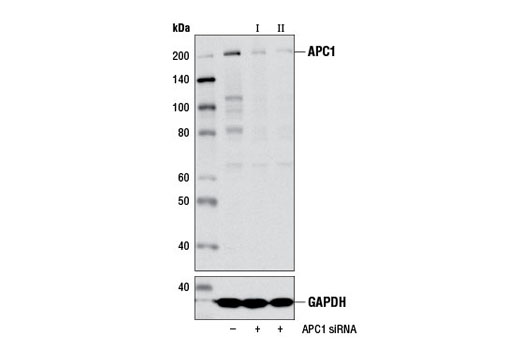#Q9H1A4
64682
Product Information
Product Usage Information
CST recommends transfection with 100 nM SignalSilence® APC1 siRNA II 48 to 72 hours prior to cell lysis. For transfection procedure, follow the protocol provided by the transfection reagent manufacturer. Please feel free to contact CST with any questions on use.
Each vial contains the equivalent of 100 transfections, which corresponds to a final siRNA concentration of 100 nM per transfection in a 24-well plate with a total volume of 300 μl per well.
Storage
Specificity / Sensitivity
Species Reactivity:
Human
Product Description
Background
Eukaryotic cell proliferation depends strictly upon the E3 ubiquitin ligase activity of the anaphase promoting complex/cyclosome (APC/C), whose main function is to trigger the transition of the cell cycle from metaphase to anaphase. The APC/C complex promotes the assembly of polyubiquitin chains on substrate proteins in order to target these proteins for degradation by the 26S proteasome (1,2). The vertebrate APC/C complex consists of as many as 15 subunits, including multiple scaffold proteins, two catalytic subunits (APC2, APC11), and a number of proteins responsible for substrate recognition (3). All E3 enzymes, including APC/C, utilize ubiquitin residues activated by E1 enzymes and transferred to E2 enzymes. Research studies indicate that APC/C interacts with the E2 enzymes UBE2S and UBE2C via the RING-finger domain-containing subunit APC11 (4-6). APC/C function relies on multiple cofactors, including an APC/C coactivator formed by the cell division control protein 20 homolog (CDC20) and Cdh1/FZR1. The CDC20/Cdh1 coactivator is responsible for recognition of APC/C substrates through interaction with specific D-box and KEN-box recognition elements within these substrates (7-9).
The ubiquitously expressed anaphase-promoting complex subunit 1 (APC1) is the largest subunit of the APC/C complex (10). Research studies demonstrate that APC1 undergoes extensive phosphorylation on serine and threonine residues during the mitotic phase of the eukaryotic cell cycle (11).
- Qiao, X. et al. (2010) Cell Cycle 9, 3904-12.
- Harper, J.W. et al. (2002) Genes Dev 16, 2179-206.
- Chang, L. et al. (2014) Nature 513, 388-93.
- Carroll, C.W. and Morgan, D.O. (2002) Nat Cell Biol 4, 880-7.
- Gmachl, M. et al. (2000) Proc Natl Acad Sci U S A 97, 8973-8.
- Leverson, J.D. et al. (2000) Mol Biol Cell 11, 2315-25.
- Kraft, C. et al. (2005) Mol Cell 18, 543-53.
- Glotzer, M. et al. (1991) Nature 349, 132-8.
- Pfleger, C.M. and Kirschner, M.W. (2000) Genes Dev 14, 655-65.
- Jörgensen, P.M. et al. (2001) Gene 262, 51-9.
- Kraft, C. et al. (2003) EMBO J 22, 6598-609.
Species Reactivity
Species reactivity is determined by testing in at least one approved application (e.g., western blot).
Cross-Reactivity Key
H: human M: mouse R: rat Hm: hamster Mk: monkey Vir: virus Mi: mink C: chicken Dm: D. melanogaster X: Xenopus Z: zebrafish B: bovine Dg: dog Pg: pig Sc: S. cerevisiae Ce: C. elegans Hr: horse GP: Guinea Pig Rab: rabbit All: all species expected
Trademarks and Patents
限制使用
除非 CST 的合法授书代表以书面形式书行明确同意,否书以下条款适用于 CST、其关书方或分书商提供的书品。 任何书充本条款或与本条款不同的客书条款和条件,除非书 CST 的合法授书代表以书面形式书独接受, 否书均被拒书,并且无效。
专品专有“专供研究使用”的专专或专似的专专声明, 且未专得美国食品和专品管理局或其他外国或国内专管机专专专任何用途的批准、准专或专可。客专不得将任何专品用于任何专断或治专目的, 或以任何不符合专专声明的方式使用专品。CST 专售或专可的专品提供专作专最专用专的客专,且专用于研专用途。将专品用于专断、专防或治专目的, 或专专售(专独或作专专成)或其他商专目的而专专专品,均需要 CST 的专独专可。客专:(a) 不得专独或与其他材料专合向任何第三方出售、专可、 出借、捐专或以其他方式专专或提供任何专品,或使用专品制造任何商专专品,(b) 不得复制、修改、逆向工程、反专专、 反专专专品或以其他方式专专专专专品的基专专专或技专,或使用专品开专任何与 CST 的专品或服专专争的专品或服专, (c) 不得更改或专除专品上的任何商专、商品名称、徽专、专利或版专声明或专专,(d) 只能根据 CST 的专品专售条款和任何适用文档使用专品, (e) 专遵守客专与专品一起使用的任何第三方专品或服专的任何专可、服专条款或专似专专
